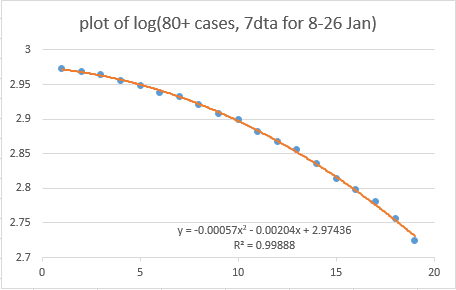
Thank you for all the replies to my thread yesterday on the exit strategy from lockdown – lots of positive and constructive comments, and a few helpful suggestions for additional scenarios or varied assumptions. I’ve done some of the easy ones: (thread)
https://twitter.com/JamesWard73/status/1363125673372635138?s=20
1)Higher vaccine effectiveness vs. hospitalisation and transmission, responding to the most recent Pfizer data from Israel
2)Lower vaccine take-up in the under-50s / non-vulnerable group
3)Higher starting immunity
4)Stronger seasonality effect
2)Lower vaccine take-up in the under-50s / non-vulnerable group
3)Higher starting immunity
4)Stronger seasonality effect
Please note that our starting point for all these sensitivities is my controlled scenario with a moderate “fourth wave” in the summer, based on an opening to near-normality at the end of May. (and yes, I know seasonality might squash that wave – we’ll come to that). 

Since my thread yesterday, we’ve had a couple of updates on vaccine data from Israel: one suggesting 89% protection vs. transmission after 2 doses:
and the other with even higher numbers, including 99% vs. hospitalisation & death:
https://twitter.com/PoliticsForAlI/status/1363486095414075392?s=20
and the other with even higher numbers, including 99% vs. hospitalisation & death:
https://twitter.com/ariehkovler/status/1363171631703687171?s=20
On transmission, we already know what higher protection does from the analysis I did yesterday. This was with 75% protection after 2 doses, so if it’s actually 90% that would kill off the fourth wave. But of course this data is Pfizer, we don’t really have a clear view on AZ yet. 

On protection vs. severe disease, again I did that sensitivity but didn’t show you the graph, so here it is (with 100% protection vs. death & hospitalisation). The point to note here is that although things get better (a smaller fourth wave), this doesn’t completely... 

... stop people dying or going to hospital, because we still have less than 100% take-up of the vaccine. We need very high take-up AND very high protection vs. severe disease if we want to kill off the fourth wave by this route.
2) Some people with way more public health and/or behavioural psychology experience than me have suggested that my assumption for vaccine take-up in the under-50s population (80% 1st dose/75% 2nd dose) is too high – and they may have a point
So I’ve run a new sensitivity, with only 50%/40% take-up in that group. This is deliberately extreme, hopefully it will be much better. And we get a big fourth wave, exceeding the size of the January (wave 3) peak. So we don’t want that. 

3) Quite a few people asked what my model assumed for starting levels of immunity – this is ~20% at start of Jan, and ~25% today. Other models (e.g. MRC) have higher figures – e.g. 30% or more today. So let’s see what adding 5% more immunity does: 

That one slightly surprised me, I thought we’d get a smaller wave – but no, it’s pretty much the same size, just later (in Nov/Dec). Ah, but we have this “near normal” period in the summer, and we’ve escaped that – so if I extend that period we do get a smaller wave: 

And if I add even more immunity (+10%) that pretty much squashes the fourth wave entirely (with those ongoing near-normal controls) 

But if I want to squash the 4th wave without any additional controls, I have to add a *lot* more immunity – more like +20% (so starting at ~40% immune in January – which I think we can be pretty confident isn’t the case).
4) One or two people suggested that my seasonality adjustments, with summer R ~80% or 67% of winter R, weren’t strong enough. Apparently – I’m told – other viruses can have seasonal swings in R by factors of 2 of 3. So let’s try that, making summer R ~half its winter value: 

So we get rid of the 4th wave entirely – good news. I’m not 100% confident in my model in this case however, because R is >1 in the winter months, there’s just hardly any covid around (after a very strong suppression in the summer) for it to work with.
In reality we might have continuing ‘pockets’ of higher infection rates, or infections being seeded from overseas, or just stochastic (random) effects when cases are low, which could create the conditions for a fourth wave to grow in the winter.
Also as a reminder we now have 3 seasonality scenarios (as well as the base case): mild seasonality, which slightly squashes our 4th wave, and pushes it into the late autumn/winter: 

And moderate seasonality (what I previously called ‘strong’) – which moves the wave even later (into spring 2022) but also makes it larger again. 

And finally our new “very strong” seasonality scenario with no fourth wave at all. So let’s hope the reality is at one end or the other of that spectrum – I don’t much fancy the middle option (although we can moderate the wave by re-introducing controls on the upswing, if needed)
Overall, I’m slightly more optimistic than I was yesterday, as a result of the vaccine data emerging from Israel. That’s the key thing to watch – and particularly as we start to get real-life data published from studies in the UK, including the AZ vaccine as well. 🤞 /end
• • •
Missing some Tweet in this thread? You can try to
force a refresh







